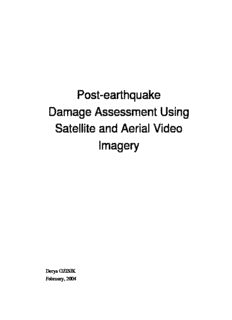
Post-earthquake Damage Assessment Using Satellite and Aerial Video Imagery PDF
Preview Post-earthquake Damage Assessment Using Satellite and Aerial Video Imagery
Post-earthquake Damage Assessment Using Satellite and Aerial Video Imagery Derya OZISIK February, 2004 Post-earthquake damage assessment using satellite and aerial video imagery by Derya OZISIK Thesis submitted to the International Institute for Geo-information Science and Earth Observation in partial fulfilment of the requirements for the degree of Master of Science in Urban Planning and Land Administration. Degree Assessment Board Prof. Dr. Douglas R. WEBSTER (Chairman) Dr. Stan C.M. GEERTMAN (External Examiner) Dr. Norman KERLE (First Supervisor) Drs. Paul HOFSTEE (Second Supervisor) INTERNATIONAL INSTITUTE FOR GEO-INFORMATION SCIENCE AND EARTH OBSERVATION ENSCHEDE, THE NETHERLANDS I certify that although I may have conferred with others in preparing for this assignment, and drawn upon a range of sources cited in this work, the content of this thesis report is my original work. Signed : ……………….. Disclaimer This document describes work undertaken as part of a programme of study at the International Institute for Geo-information Science and Earth Observation. All views and opinions expressed therein remain the sole responsibility of the author, and do not necessarily represent those of the institute. (cid:1)(cid:1)(cid:1)(cid:1)(cid:2)(cid:2)(cid:2)(cid:2)(cid:3)(cid:4)(cid:3)(cid:5)(cid:6)(cid:7)(cid:8)(cid:4)(cid:3)(cid:9)(cid:8)(cid:10)(cid:9)(cid:11)(cid:12)(cid:9)(cid:11)(cid:10)(cid:11)(cid:13)(cid:9) (cid:14)(cid:12)(cid:15)(cid:4)(cid:16)(cid:9), (cid:17)(cid:18)(cid:10)(cid:9)(cid:7)(cid:16)(cid:17)(cid:7)(cid:12)(cid:15)(cid:9)(cid:4)(cid:19)(cid:6)(cid:10)(cid:20)(cid:21)(cid:7)(cid:22)(cid:4)(cid:9) (cid:7)(cid:19)(cid:3)(cid:9)(cid:22)(cid:7)(cid:23)(cid:4)(cid:9)(cid:11)(cid:4)(cid:9)(cid:15)(cid:8)(cid:21)(cid:4)(cid:19)(cid:22)(cid:8)(cid:18)(cid:9)(cid:8)(cid:10)(cid:9)(cid:22)(cid:10)(cid:9)(cid:10)(cid:19)(cid:1)(cid:2)(cid:2)(cid:9)(cid:9)(cid:9)(cid:9) ABSTRACT To date, prevention of natural disasters is only rarely achieved, and such events continue to pose an increasing threat to life and property. Especially following earthquakes, typically unheralded events associated with widespread destruction and high mortality, there is a need for rapid, accurate and reliable damage information in the critical post-event hours to guide response activities. In reality, it is still difficult to obtain that information rapidly, because of interruptions in communication sys- tems and access difficulties in remote areas. Moreover, in the time of emergency, data coming from different sources create confusion and decrease the reliability of information. Remote sensing systems can provide valuable information for response activities. However, the use of remote sensing technol- ogy in post-earthquake urban damage assessment is still limited, since it requires not only high spatial- temporal resolution and rapid response but also a 3D view to assess structural damage. Besides these technical limitations, there is also a gap between emergency managers and remote sensing technology, especially in developing countries. Information derived from remote sensing technology, however, is only valuable if it fulfils the requirements of the user. This work aims at integrating vertical satellite and oblique airborne imagery to improve dam- age assessment, not in a sense of image fusion, but of synergy. Moderate-resolution satellite imagery was used to detect damaged areas at the regional level. Since vertical satellite imagery (even of high spatial resolution) has limitations in detecting structural damage, in particular pancake damage, air- borne oblique imagery was used to improve the damage information at the local level. Those data can provide critical façade information that gives more meaningful insight into the state of damage than vertical data can provide. Moreover, vector data were used as an additional data source to enhance the utility of the image data and to aid in the data registration process. On the other hand, to determine the effectiveness of the use of remote sensing technology in emergency activities and to create a link be- tween academic research and real life problems, user information requirements were investigated by interviewing emergency organizations in Turkey, where the case study area is located. Pre and post-earthquake Spot XS/PAN and post-earthquake aerial video imagery were used in the case of the 1999 Marmara earthquake, Turkey. Pixel-based change detection methodology was applied to derive damaged areas. Detectable damage at the regional scale (urban and rural areas) was investigated. Aerial video imagery of Golcuk, taken by a Turkish media agency, was used to derive digital image frames. The information content of the video frames was enhanced using Astrostack, which integrates a sequence of frames to improve the image quality. Damage detection analysis of video frames was carried out at three levels: (i) visual interpretation, (ii) digital analysis, (iii) further experiments on methodology. Color indices, edge elements and their variance were used as feature layers for threshold based classification in digital analysis of video imagery. Further experiments were carried out by line detection, conditional unidirectional local variance and local binary patterns. The results indicate significant limitations of moderate-resolution optical satellite imagery for post-earthquake damage assessment. Vector data integration has valuable contribution for the evalua- tion and visualization of the results. Despite substantial processing, registration and integration chal- lenges of video imagery, it can improve damage assessment at the local level, since it provides infor- mation about damage, which can be seen from the building facades. Digital analysis of video imagery can overcome time requirement and subjectivity problems of visual interpretation. Although the meth- odology applied in this research is threshold based, it is promising, as it improves damage assessment compared with Spot imagery analysis. Further experiments, which aims to find a generic methodology based on geometry and texture characteristic of the objects, was not successful due to poor spatial resolution, high oblique characteristic and texture characteristics of the urban scene. Further research on finding a generic methodology, registration and mosacing of highly oblique video imagery will im- prove the damage assessment result. On the other hand, even using video imagery cannot fulfill the information requirements of the user, as most of the information requires integration of GIS and RS data. For effective use of informa- tion between different, there is a need for organizational improvements in terms of data network, tech- nical infrastructure and expertise.
Description: